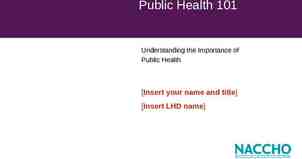RPMS Optimization Elvira Mosely, MSHS, RN 1
36 Slides1.05 MB
RPMS Optimization Elvira Mosely, MSHS, RN 1
Learning Objectives Explain the importance of precise information technology setup, configuration and maintenance. Review the clinical components of an electronic health record and how proper configuration and optimization impact end-user functionality. Discuss the importance of identifying RPMS Package Owners who will accept responsibility for on-going maintenance of individual components of an electronic health record. Work collaboratively across disciplines to define, discuss and plan a process for updating and maintaining components of an electronic health record and the importance of communicating changes and updates to end-users. 2
Are My Site’s Patches Current? How do I determine current patch level? Use the menu option Display Patches for a Package in Kernel Installation and Distribution Package (KIDS). Menu option may only be available to Site Manager. For the latest software versions and patches of RPMS Packages: http://www.ihs.gov/Cio/RPMS/index.cfm? module home&option software 3
RPMS Packages Important to EHR Adverse Reaction Tracking: (GMRA) Contract Health: (ACHS) Diabetes Management System: (BDM) Health Summary (IHS): (BHS) Immunization: (BI) Laboratory: (LR) Patient Information Management: (PIMS) Patient Registration (AG) Pharmacy: (Multiple packages) Radiology: (RA) Referred Care Information System: (BMC) Third Party Billing: (ABM) Text Integration Utilities: (TIU) VA Health Summary: (GMTS) Women's Health: (BW ) 4
Some RPMS Packages Important to EHR The list on the previous slide is not exhaustive, any infrastructure RPMS package may impact EHR. Other important packages related to EHR: Fileman: (DI) PCC: (BJPC) iCare: (BQI) Emergency Room System: (AMER) RPMS Kernel: (XU) 5
Some RPMS Packages Important to EHR Generally speaking, all RPMS packages need to have the latest patches installed to maintain proper operation of EHR and to maintain correct functions for GPRA, CRS, and Meaningful Use. If a particular package is not maintained, at a future date you may discover a different package requires the package in question being patched up to current level. In this instance, you would have to install all missing patches before being able to proceed. 6
Adverse Reaction Tracking Data Entry Staff: Assign GMRA-USER key and use the ALG mnemonic to document allergies in PCC. Do not place allergies on the Problem List! Run this option periodically: PLAL Reports Listing Allergies recorded on PROBLEM LIST EHR Users: Enter allergies into the Adverse Reaction Tracking Package and remove any allergies from the Problem list. Pharmacy: Assign a pharmacist trained to use the Adverse Reaction Tracking package to review and verify all new allergies entered using EHR. Sites with no pharmacist may choose to utilize Auto-Verify of Allergies. 7
Contract Health and HIM CHS and medical records staff should collaborate to identify a process to include notice that outside referral and diagnostic reports have been returned to the facility and are available for provider review. This process may be included in notifications so that both the provider and the CHS staff will be informed of the completed contract health service item. 8
Diabetes Management System Diabetes registry must be configured and updated with new diabetic patients. Lab taxonomies must be maintained consulting with laboratory informaticist for names of lab tests at your facility. Medication taxonomies must be maintained consulting with pharmacy for medications used at your facility. Build smart Health Summary with Diabetes Supplement. Periodically conduct Automated Diabetes Audit and compare to Hand Audit using the same patient cohort. 9
Health Summary (IHS) Sites need to build and maintain Health Summaries needed by providers. Build and maintain smart Health Summaries with supplements for asthma, anticoagulation, diabetes, pre-diabetes, and women's health. 10
Immunization Assign BIZMENU key and BIZ EDIT PATIENTS key to all users who enter immunizations. Periodically review all vaccines using the option: VAC Vaccine Table Edit Activate vaccines in use. Inactivate vaccines not used. Periodically review all vaccine lot numbers using the option: LOT Lot Number Add/Edit Activate lot numbers in use. Inactivate lot numbers no longer in use. Review Vaccine Information Sheet (VIS) dates within Vaccine Table. 11
Immunization (continued) Review the site parameters using the option: ESP Site Parameters Edit ensuring that lot numbers are required. Determine who will enter new lot numbers into the Immunization Package when they arrive (i.e., immunization nurse or pharmacy tech), if it will be a pharmacy tech, assign the menu option: LOT Lot Number Add/Edit 12
Immunization (continued) Entry of Immunizations is now encouraged using a Super-Bill. For entry via Super-Bill, an Immunization pick list must be created. For each Immunization add associations: Immunization CPT for the syringe Education code for literature Education code for follow-up. 13
Laboratory The following functions should be done by the laboratory informaticist: Review laboratory exam CPT codes: (Lab menu BLR menu CPT) Review accession test groups (menu of tests) and create new accession test groups to be used by clinics and wards. Ensure that setup for both point-of-care and reference lab tests results display in the Lab Package. 14
Laboratory (continued) Review all tests in the Laboratory Test file (File 60) and inactivate tests no longer in use: Set the type to Neither. Review holders of the LRLAB Key. Assign LOINC codes to lab tests in the Laboratory Test File (contact OIT for assistance). Review setup of label printers for clinics, ER, and inpatient to be used for EHR orders. 15
Laboratory (Prep for Point of Care Lab component) Identify what point-of-care (POC) labs you plan to use at your facility: Give list to Lab Package Administrator. Review EHR v1.1p5 notes and implementation guide. Lab Package Administrator should make sure the labs are set up correctly in the lab package according to the POC documentation provided with EHR v1.1p5 and the Lab Package. Determine process for POC labs: What locations (clinics) will use POC labs? Who (what personnel) will perform tests and enter results? Ensure policies and procedures are in place to support POC lab use. Add POC Lab component to the EHR GUI like any other component using Design mode. Use FileMan to complete configuration in the file called BLR BEHO POC CONTROL. 16
POC Lab component 17
BLR BEHO POC CONTROL FILE 18
Laboratory (continued) Non-laboratory CACs are strongly discouraged from modifying laboratory files. The exception being those small sites without a Lab who have attended the EHR-Lab for Non-Laboratorians class. 19
Pharmacy The following functions should be done by the Pharmacy Informaticist: Clean & maintain drug file in Pharmacy 5/7: Major file cleanup efforts Pharmacy 7 EHR for Inpatient ePrescribing BCMA Maintain Pharmacy Data Management: Control access Reports 20
Pharmacy Assist with integration of RPMS and other systems: Automated dispensing systems EHR BCMA Understand how changes in RPMS impact pharmacy systems. Facilitate utilization of the Paperless Refill option. Facilitate utilization of the EHR Coding Queue for managing Paperless Refills. Facilitate development and tracking of staff training: Baseline and updates Not just pharmacists 21
Pharmacy Oversee pharmacy related patches working with site manager. NDF Patches: Ensure installation. Perform post-install maintenance. EHR Patches: Review install guides. Configure any pharmacy related parameters, etc. Other Patches that may impact pharmacy: Allergy Immunizations Point of sale 22
Pharmacy The drug file impacts many areas and small changes can have big consequences elsewhere. Non-Pharmacy CACs are strongly discouraged from modifying pharmacy files. The exception being those small sites without an onsite pharmacist. 23
Radiology Review Radiology Order menu ensuring it meets provider needs. Inactivate procedures if no longer in use. Review radiology exams periodically: Radiology package Supervisor’s menu Utility File Maintenance menu Procedure Edit menu. Review CPT Codes periodically. 24
Radiology (continued) Review process for radiology orders that need to be overridden to completion if Radiology Report is not entered into Radiology Package. Ensure process for getting Radiology Reports into Radiology Package is functioning. 25
Referred Care Information System (RCIS) Delineate the steps of the referral process (e.g., how are referrals entered into the system). Ensure the Link between RCIS and PCC is working. Review template(s) within the RCIS application to be utilized by your facility to populate data on the purchase order (local category prompts). Ensure RCIS Site Parameters are configured according to local practices and data and report needs. 26
Scheduling (PIMS) Ensure clinic setup for locations within your facility are correct for: Visit Type: Phone call Chart review Coordination of care or case management Pharmacy Lab Radiology Service category Ensure clinics create visit at check-in. Delineate your process to consistently check in patients. 27
Third Party Billing/Medical Records Review the PCC Master Control file and ensure that all of the packages are set to pass data to PCC using the menu option: UPMC Update PCC Master Control File 28
Suggested Packages to Include in the Master Control File Contract Health Mgmt System: (ACHS) Diabetic Tracking System: (BDM) ER Visit System: (AMER) IHS Behavioral Health: (AMH) IHS Dental: (ADE) IHS RPMS CHR System: (BCH) Health Summary: (BHS) Lab Service: (LR) IHS Laboratory: (BLR) Outpatient Pharmacy: (PSO) Pharmacy: (PS) PIMS: (PIMS) Radiology/Nuclear Medicine: (RA) Registration: (DG) Referred Care Info System: (BMC) Women's Health: (BW) 29
Third Party Billing/Medical Records Review the Third Party Billing package site parameters for correct configuration 30
Medical Records Review EHR Coding Queue (PCC Data Entry Patch 8). Review Coding Paperless Refills process. Periodically review all fields of Health. Summaries and update as necessary. Review process for tracking providers utilizing EHR. 31
Women’s Health Ensure site parameters are configured and updated as required. Ensure link to Pass Procedures to PCC. Review case managers setup and update as required. Review letters setup and update as required. Review PAP smears process. - Lab package and/or the Women’s Health package. Review the system for entering PAP results in Women’s Health package. 32
Women’s Health (continued) Review system for entering mammography exam, breast exams, and biopsies into Women’s Health. Review system for printing letters and tracking delinquent reports. 33
Summary Remember that the primary CAC is not directly responsible for all of these packages. It is important that a package owner be identified and be made responsible to configure, review, and maintain each package. 34
Summary The status of RPMS packages should be reviewed periodically by the EHR Working Committee to ensure correct configuration is maintained, patches are installed, and updates are made as needed. 35
Questions and Discussion 36









































